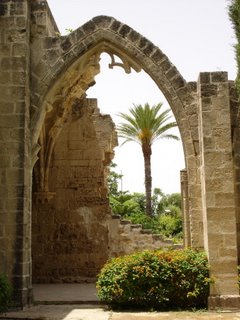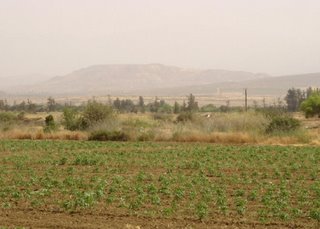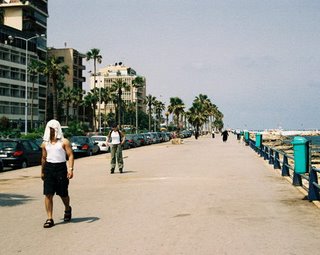I have a question for my British friends. Is it written somewhere that "on holiday" British tourists must stay up and party until 2 or 3AM, making as much noise as possible? It seems that almost every hotel I' ve stayed in, each having a high percentage of British clientele, plays loud music until late at night. No-one goes to sleep until extremely late, and the more they drink, the rowdier they become. The Sempati Hotel in Kyrenia, where I stayed last night, was no exception. As everyone who knows me will attest, I become Oscar the Grouch when I haven't had enough sleep.
Harumph. After breakfast, I decided to pack up and head out for the town where I and my siblings were born. First, I detoured to the East to a little town nestled in the foothills of the Pentadaktilos mountains called Bellapais. In this village, clinging to a ledge, there is a very old abbey built around 1100AD. I toured the ruins in the sweltering heat and then trudged up the hill to find the home of British author, Lawrence Durrell. This pilgrimage was for my children. When they were young, we read the book, "My Family and Other Animals" by Gerald Durrell, Lawrence's brother. It was a hilarious account of Gerry's family's life on the island of Corfu. He often mentioned the antics of his brother, Larry. When Larry grew up, he moved to Bellapais and wrote a famous book about Cyprus called "Bitter Lemons". I had intended to read it before coming on this trip, but didn't manage it. I will certainly pull it out of my bookshelf when I get home.
 Bellapais Abbey
Bellapais Abbey Through an arch of the Abbey.
Through an arch of the Abbey.
 Bitter Lemons, Lawrence Durell's home in Bellapais
Bitter Lemons, Lawrence Durell's home in BellapaisAfter seeing the abbey and Lawrence Durrell's home, I decided to find out if I could locate the exact spot where one of the paintings in my office was created. It is the one with the little house in the middle of the foreground and the five fingers of the Pentadaktilos range in the background. I came upon extensive olive groves in this area, and also many new homes. Nothing looks quite the way it used to:

Then it was off to drive to the West towards Pendayia and Xeros in Morphou Bay.
The remainder of this posting may only mean something to my family as I will recount my journey back in time, again:
The drive from Kyrenia to the West took longer than it seemed it should have when looking at the map. I don't recall ever going this way before, and it is more mountainous than it appears on paper. Finally, I drove into Morphou from the East. Orange groves stretched out as they used to with rows of Cypress trees acting as windbreaks. Several orange juice stands offered freshly squeezed juice. My mouth watered, but I was out of Turkish Lira and the ATM at the Turkish Bankasi in Morphou spat my ATM card out. Didn't like it for some reason, or maybe they don't give out money on Sunday?
Soon, the Mediterranean sparkled between the eucalyptus trees that appeared on my right. I kept my eyes open for the road to Pendayia Hospital (where I was born). There it was, with a hospital sign above it in Turkish. Slowly, I drove down the road, wondering how the golf-course would look and if the hospital was still in use. The fairway on the left was overgrown with weeds, but the one on the right was just as it used to be. In fact, sprinklers were watering as I drove by. The greens are still black with oil instead of deep green with closely mown grass. I have a nice photo down the fairway between the road to the doctors houses and the road to the hospital.
 Looking down the Fairway
Looking down the FairwayWhen I got to the hospital buildings, they appeared a little rundown. A couple of ancient ambulances sat parked in a driveway. The hospital looked as if it is still in use, but the waiting room was empty. I heard echoes of children crying as I remembered how the people would crowd into the waiting room hoping to be seen by a doctor. It usually seemed oppressively hot in there and it wasn't air-conditioned. The overseas staff always got to go first. I felt a little guilty about that in that moment.
 A View of the Hospital in Pendayia
A View of the Hospital in PendayiaOut on the road to Xeros, I came in full view of the bay. No red water (from dumping the dregs of the milling process), of course. When I arrived at the jetty that was connected to the mill, where the company used to process the copper ore in preparation for shipment, I noticed a little "restaurant" at the base of it. Get this. It was called
The CMC Pub, Museum, and Restaurant! I parked and got out to see what it was all about. I met the owner, who said that his father used to work for CMC (Cyprus Mines Corporation). When the government dismantled the mill operation, this guy went over and salvaged what he could from the wreckage. He had hung at least a half dozen, black and white, posed photographs of groups of mill workers in frames on the wall. Uncle David (Marr), a close family friend, was in every one of them. The restaurant owner had also picked up an old (now antique) typewriter, something that looked like an adding machine, and various plaques from machinery. I took photos of the photos and some of the abandoned mill operation across the street with Mavrovouni in the background.
 The CMC Jetty (in the foreground)
The CMC Jetty (in the foreground) Uncle David (Marr) and the Mill Workers
Uncle David (Marr) and the Mill Workers
 CMC Machine Shop - 13 March 1968
CMC Machine Shop - 13 March 1968
 The Abandoned CMC Mill
The Abandoned CMC Mill Skouriotissa from Pendayia on a very hazy day.
Skouriotissa from Pendayia on a very hazy day.
I drove on towards Xeros, which still looks remarkably the same. Apostolides' old grocery store now has several enterprises in it, including a small bank. I tried the ATM card again with no luck. Driving up the road towards Karavostassi, all the little houses on each side seem to have been frozen in time. That road was much longer than I remember, though. At the top of it, where we used to turn to go up the hill, there is a roundabout (I should do one whole posting on roundabouts!), which you must go around before you can drive up Karavostassi hill. The old house on the left at the bottom of the hill is still there. I remember it as being fairly run-down even when we lived there; it has crumbled even more. I think someone still lives there though.
Up on Karavostassi hill, the homes are in worse shape than the ones in Skouriotissa. The Marrs' original house has been painted bright yellow, and I think that is the only maintenance or painting that has been done in 30 years. Fence posts are missing, and the ones that remain haven't seen paint since the CMC workers did it. I saw the garages where my brothers lit the field on fire when they were smoking cigarettes at about age 7. The field is still there and so are the garages. At the top of the road to the right, is a university campus with apartments. It is called something like "The European University of Lefke (Lefka)". Down on the road towards Lefka, at the junction to the road to Mavrovouni, many new homes have been hastily constructed, or "plunked" as I see it. I tried to drive down the old road to Mavrovouni, but after one or two houses, it petered out. Not maintained at all.
At that point, I decided to return to Nicosia, and then back to Larnaca. Tonight, I am staying in the same little hotel I chose for the first few days (Lysithea). I slept well then, and will try to do the same in preparation for my return on Tuesday. My flight leaves at 4AM, so I will need to store up on the shut eye before then.
 Now that I am back home and almost free of jet-lag, I am in the process of uploading pictures to enhance this narrative. Please check back often for photographic and journal additions.
Now that I am back home and almost free of jet-lag, I am in the process of uploading pictures to enhance this narrative. Please check back often for photographic and journal additions. Then it was off to drive to the West towards Pendayia and Xeros in Morphou Bay.
Then it was off to drive to the West towards Pendayia and Xeros in Morphou Bay. On Friday, I decided to skip the lectures and the movie and immerse myself in the experience of returning to high school and to Beirut itself. I sat under the tree in the courtyard where we spent countless recesses. Alan Whitman and I were once trying to remember what kind of tree this was (via e-mail). For his benefit, I will tell you that it is, and the three other trees in the courtyard are, carob. Some enterprising person/janitor has placed a blue, plastic bag in the hollow of the tree, no doubt to preempt students from throwing trash in there irretrievably (see it behind Lynn?). While Lynn, Gail, and I sat there in the courtyard reminiscing, the bell rang for recess and the students poured out of the academic building to congregate by the lockers. Instantly, we were transported back in time. Locker doors clanged. Students called back and forth. Chaos reigned. This could be our recess...
On Friday, I decided to skip the lectures and the movie and immerse myself in the experience of returning to high school and to Beirut itself. I sat under the tree in the courtyard where we spent countless recesses. Alan Whitman and I were once trying to remember what kind of tree this was (via e-mail). For his benefit, I will tell you that it is, and the three other trees in the courtyard are, carob. Some enterprising person/janitor has placed a blue, plastic bag in the hollow of the tree, no doubt to preempt students from throwing trash in there irretrievably (see it behind Lynn?). While Lynn, Gail, and I sat there in the courtyard reminiscing, the bell rang for recess and the students poured out of the academic building to congregate by the lockers. Instantly, we were transported back in time. Locker doors clanged. Students called back and forth. Chaos reigned. This could be our recess... The current headmaster, George Damon, lives with his family in the penthouse. There is a brand new ACS sign in front of the old boys' BD (boarding department) . Instead of the table to the right, there is a spiffy, new fountain surrounded by flags. The bench to the left of the BD entrance, where we sat so often - waiting for meals, waiting to sign out, or just hanging out - still exists. Frozen in time. There is no girls' BD. The building is still there, but it's not part of ACS any more. Kameel's shop is gone. So are Eddy's and Washington's hang outs.
The current headmaster, George Damon, lives with his family in the penthouse. There is a brand new ACS sign in front of the old boys' BD (boarding department) . Instead of the table to the right, there is a spiffy, new fountain surrounded by flags. The bench to the left of the BD entrance, where we sat so often - waiting for meals, waiting to sign out, or just hanging out - still exists. Frozen in time. There is no girls' BD. The building is still there, but it's not part of ACS any more. Kameel's shop is gone. So are Eddy's and Washington's hang outs. Rollerblading on the Corniche
Rollerblading on the Corniche Fishing off the Rocks
Fishing off the Rocks Once we made our Hard Rock purchases and walked back on the other side of the Corniche, we entered the AUB (American University of Beirut) campus, showing our ID badges as we passed the guard. Trudging up the stairs, we came to the familiar banyan tree and then exited the main gate onto Rue Bliss. You can still get a great shawarma here, at Bliss House. It's just a little more organized and a slightly bigger establishment. Now you pay at the cash register on one side of the stand and retrieve your shawarma on the other. You can have chicken or beef. (Could it be camel?? We never quite knew for sure...) Fresh orange juice is offered at many shops. Though I didn't see any carts uptown for orange juice, there was one down on the Corniche (see photo above). I bought some green plums from a guy with a cart. Remember the green plums that would give you a tummy ache if you ate too many?
Once we made our Hard Rock purchases and walked back on the other side of the Corniche, we entered the AUB (American University of Beirut) campus, showing our ID badges as we passed the guard. Trudging up the stairs, we came to the familiar banyan tree and then exited the main gate onto Rue Bliss. You can still get a great shawarma here, at Bliss House. It's just a little more organized and a slightly bigger establishment. Now you pay at the cash register on one side of the stand and retrieve your shawarma on the other. You can have chicken or beef. (Could it be camel?? We never quite knew for sure...) Fresh orange juice is offered at many shops. Though I didn't see any carts uptown for orange juice, there was one down on the Corniche (see photo above). I bought some green plums from a guy with a cart. Remember the green plums that would give you a tummy ache if you ate too many? The Banyan Tree
The Banyan Tree Rue Bliss
Rue Bliss We were welcomed with some lovely Arabic tunes as we all strolled into the venue. Waitors brought everyone drinks and we chatted and visited. The tennis court area was covered with multiple white tents, underneath which were rows and rows of tables with fresh sunflower center-pieces. There was a stage at one end and meal prep occuring at the other end.
We were welcomed with some lovely Arabic tunes as we all strolled into the venue. Waitors brought everyone drinks and we chatted and visited. The tennis court area was covered with multiple white tents, underneath which were rows and rows of tables with fresh sunflower center-pieces. There was a stage at one end and meal prep occuring at the other end.